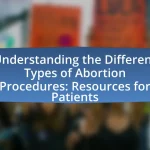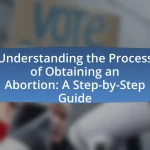The article examines the legal landscape of abortion rights across different states in the United States, highlighting the significant variations in laws and access to abortion services. It details how states like California and New York maintain strong protections for abortion rights, while states such as Texas and Alabama impose restrictive measures, including near-total bans. The piece explores key factors influencing these laws, including political ideology, public opinion, and cultural climates, as well as the historical context shaped by landmark Supreme Court decisions. Additionally, it discusses the implications of differing abortion rights on women’s health, economic opportunities, and societal equity, along with resources available for individuals seeking to understand and navigate state-specific abortion laws.
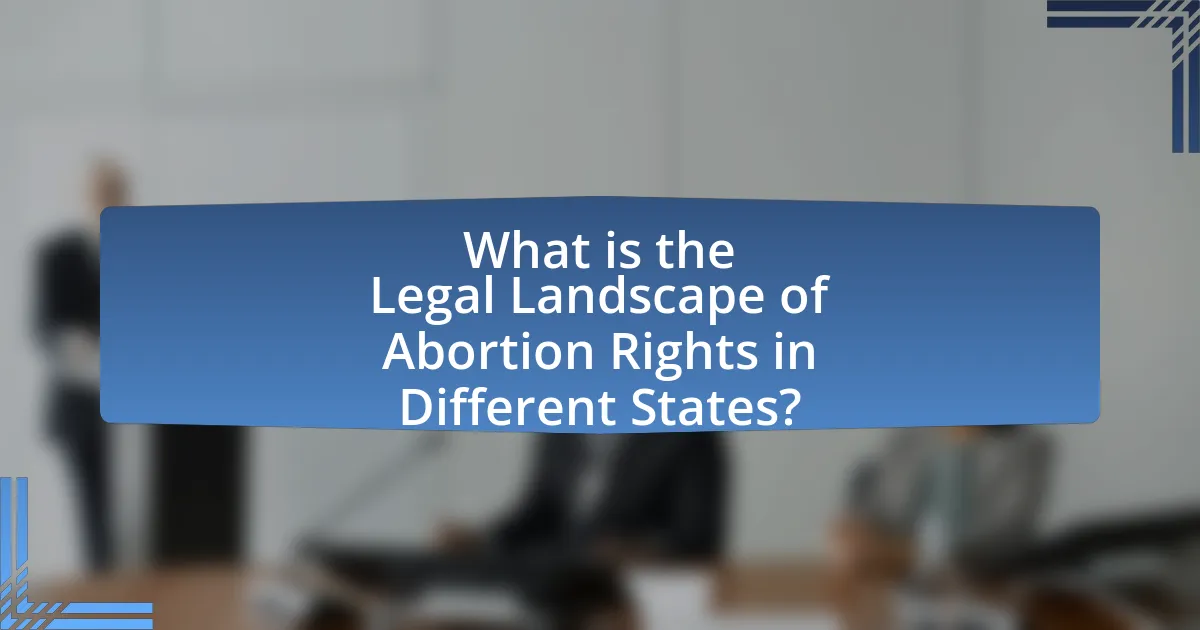
What is the Legal Landscape of Abortion Rights in Different States?
The legal landscape of abortion rights in different states varies significantly, with some states enacting restrictive laws while others maintain protections for access to abortion. For instance, as of 2023, states like California and New York uphold strong protections for abortion rights, allowing access up to viability and beyond in certain circumstances. Conversely, states such as Texas and Alabama have implemented stringent laws that severely limit access, including near-total bans with few exceptions. The Supreme Court’s decision in Dobbs v. Jackson Women’s Health Organization in 2022 overturned Roe v. Wade, allowing states to set their own abortion laws, which has led to a patchwork of regulations across the country. This divergence reflects the ongoing political and social debates surrounding abortion rights in the United States.
How do state laws vary regarding abortion rights?
State laws regarding abortion rights vary significantly across the United States, with some states enacting restrictive measures while others maintain more liberal access. For instance, as of 2023, states like Texas and Alabama have implemented stringent laws that severely limit abortion access, often banning the procedure after six weeks of pregnancy, with few exceptions. In contrast, states such as California and New York uphold more permissive laws, allowing abortions up to viability and beyond in certain circumstances. This variation is influenced by political, cultural, and social factors unique to each state, leading to a patchwork of legal frameworks that reflect differing public opinions and legislative priorities on abortion rights.
What are the key factors influencing state-level abortion laws?
Key factors influencing state-level abortion laws include political ideology, public opinion, and legislative composition. Political ideology significantly shapes the stance of state lawmakers, with conservative states typically enacting more restrictive laws, while liberal states tend to support broader access to abortion services. Public opinion also plays a crucial role; states with higher support for abortion rights are more likely to have laws that protect access. Additionally, the composition of state legislatures, influenced by party control, directly affects the passage of abortion-related legislation, as seen in states like Texas and California, where Republican majorities have led to stricter laws, while Democratic majorities have sought to expand access.
How do cultural and political climates affect abortion legislation?
Cultural and political climates significantly influence abortion legislation by shaping public opinion and legislative priorities. In regions where conservative cultural values prevail, such as in many Southern and Midwestern states, lawmakers often enact restrictive abortion laws, reflecting the beliefs of their constituents. For instance, states like Texas and Alabama have implemented stringent regulations, including mandatory waiting periods and limitations on when abortions can be performed, driven by a political climate that prioritizes pro-life policies. Conversely, in states with more liberal cultural attitudes, such as California and New York, legislation tends to protect and expand access to abortion services, as seen in laws that safeguard reproductive rights against federal restrictions. This divergence illustrates how cultural beliefs and political ideologies directly translate into the legal frameworks governing abortion, impacting access and rights across different states.
What historical context shapes current abortion rights in the U.S.?
The historical context that shapes current abortion rights in the U.S. includes landmark Supreme Court decisions, legislative actions, and social movements. The 1973 Supreme Court case Roe v. Wade established a constitutional right to abortion, asserting that the right to privacy under the Due Process Clause of the 14th Amendment extends to a woman’s decision to terminate her pregnancy. This ruling set a precedent that influenced state laws and public opinion for decades. Subsequent cases, such as Planned Parenthood v. Casey in 1992, upheld Roe but allowed states to impose certain restrictions, reflecting ongoing debates about abortion rights. Additionally, the rise of the pro-choice and pro-life movements has significantly impacted legislation and public discourse surrounding abortion, leading to varying laws across states. As of 2023, the overturning of Roe v. Wade by the Supreme Court in Dobbs v. Jackson Women’s Health Organization has further complicated the legal landscape, allowing states to implement stricter abortion laws or bans, thus reshaping the rights and access to abortion across the country.
How did landmark Supreme Court cases influence state laws?
Landmark Supreme Court cases significantly influenced state laws by establishing legal precedents that states are required to follow. For instance, the 1973 decision in Roe v. Wade recognized a woman’s constitutional right to choose an abortion, which led many states to adjust their laws to comply with this ruling. Following Roe v. Wade, states enacted various regulations regarding abortion, but they could not outright ban the procedure, as it would conflict with the Supreme Court’s interpretation of the Constitution. Additionally, subsequent cases like Planned Parenthood v. Casey in 1992 reaffirmed Roe while allowing states to impose certain restrictions, further shaping the legal landscape of abortion rights at the state level. These rulings demonstrate how the Supreme Court’s interpretations directly impact state legislation and policy regarding abortion.
What role did the Roe v. Wade decision play in shaping abortion rights?
The Roe v. Wade decision established a constitutional right to abortion, significantly shaping abortion rights in the United States. This landmark 1973 Supreme Court ruling determined that the right to privacy under the Due Process Clause of the 14th Amendment extends to a woman’s decision to terminate her pregnancy, effectively invalidating many state laws that restricted access to abortion. The ruling set a legal precedent that influenced subsequent legislation and court decisions, reinforcing the notion that women have the autonomy to make choices regarding their reproductive health. As a result, Roe v. Wade became a foundational case in the ongoing debate over abortion rights, impacting state-level laws and the national discourse surrounding reproductive freedom.
What are the current trends in abortion legislation across states?
Current trends in abortion legislation across states show a significant increase in restrictive laws, particularly following the Supreme Court’s decision to overturn Roe v. Wade in 2022. Many states have enacted laws that either severely limit access to abortion or ban it outright, with at least 13 states implementing total bans. Conversely, some states, particularly those with Democratic leadership, are moving to protect and expand access to abortion services, with legislation aimed at safeguarding reproductive rights and increasing funding for clinics. This dual trend highlights a growing divide in abortion access based on geographic and political lines, reflecting broader societal debates on reproductive rights.
Which states have recently enacted restrictive abortion laws?
Several states have recently enacted restrictive abortion laws, including Texas, Florida, and Alabama. Texas implemented a law in 2021 that bans most abortions after six weeks of pregnancy, while Florida passed a law in 2022 that restricts abortions after 15 weeks. Alabama’s law, enacted in 2019, effectively bans nearly all abortions, with limited exceptions. These legislative actions reflect a broader trend among various states to impose stricter regulations on abortion access.
How are states responding to changes in federal abortion policies?
States are responding to changes in federal abortion policies by enacting a range of laws that either restrict or protect abortion access. For instance, following the Supreme Court’s decision in Dobbs v. Jackson Women’s Health Organization, many states, particularly in the South and Midwest, have implemented stricter abortion bans or limitations, with some states enacting laws that prohibit abortions after six weeks of pregnancy. Conversely, states like California and New York have moved to strengthen abortion rights, increasing funding for reproductive health services and enshrining protections in state law. This divergence reflects a broader trend where states are asserting their authority to shape abortion policy in response to federal shifts, leading to a patchwork of laws across the country.
How do legal challenges impact abortion rights in various states?
Legal challenges significantly impact abortion rights in various states by altering the accessibility and legality of abortion services. For instance, states like Texas and Mississippi have enacted restrictive laws that have faced legal scrutiny, resulting in court rulings that either uphold or block these regulations. In 2021, the U.S. Supreme Court allowed a Texas law banning most abortions to remain in effect while legal challenges were ongoing, demonstrating how judicial decisions can directly influence state abortion policies. Additionally, legal challenges can create a patchwork of abortion rights across the country, as some states may have more permissive laws while others impose stringent restrictions, leading to disparities in access to reproductive healthcare.
What types of legal challenges are commonly faced by abortion laws?
Abortion laws commonly face legal challenges related to their constitutionality, enforcement mechanisms, and access restrictions. Constitutional challenges often arise under the Fourteenth Amendment, particularly regarding the right to privacy and bodily autonomy, as seen in cases like Roe v. Wade and Planned Parenthood v. Casey. Enforcement challenges can involve state laws that impose waiting periods, mandatory counseling, or parental consent requirements, which may be contested for creating undue burdens on access to abortion services. Additionally, laws that restrict access based on gestational limits or target specific providers can lead to litigation, as they may violate established precedents or disproportionately affect certain populations. These challenges reflect ongoing debates about reproductive rights and the balance of state interests versus individual freedoms.
How do court rulings affect the enforcement of state abortion laws?
Court rulings significantly influence the enforcement of state abortion laws by determining their constitutionality and applicability. For instance, when a court rules that a state law violates constitutional rights, such as the right to privacy established in Roe v. Wade, that law may be blocked from enforcement. Additionally, subsequent rulings, like those from the Supreme Court, can either uphold or overturn existing precedents, directly impacting how states implement their abortion regulations. The 2022 decision in Dobbs v. Jackson Women’s Health Organization, which overturned Roe v. Wade, exemplifies this, as it allowed states to impose stricter abortion laws without federal oversight, leading to varied enforcement across the country.
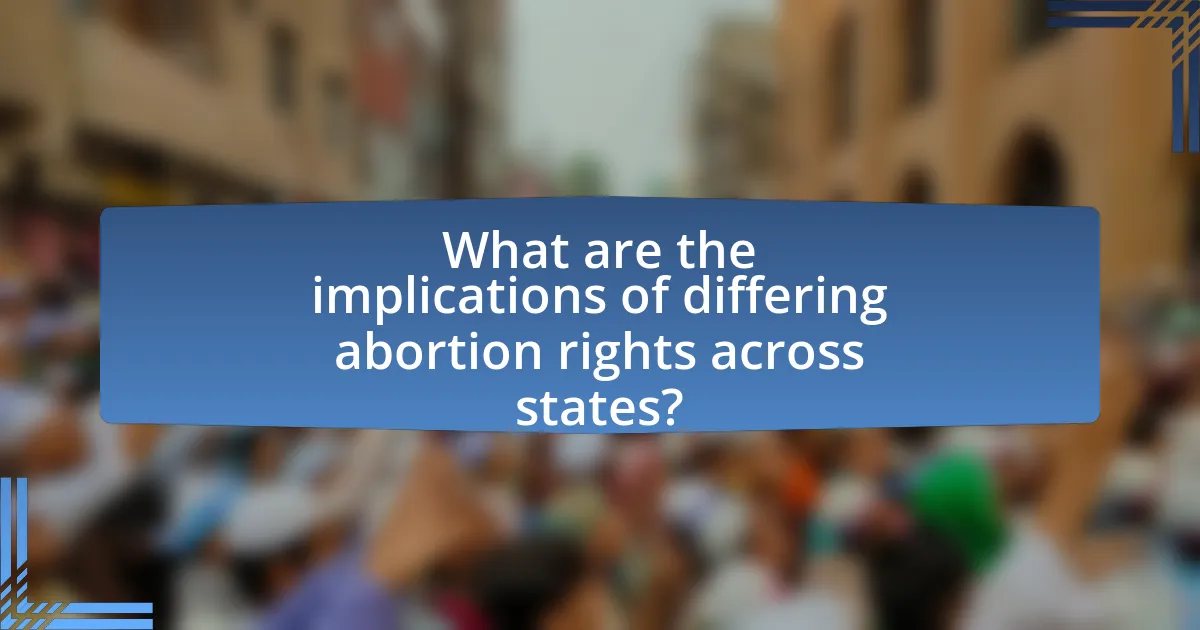
What are the implications of differing abortion rights across states?
Differing abortion rights across states lead to significant disparities in access to reproductive healthcare, impacting women’s health outcomes and socioeconomic status. For instance, states with restrictive abortion laws often see higher rates of maternal mortality and unintended pregnancies, as evidenced by a study published in the American Journal of Public Health, which found that women in states with more restrictive laws faced greater barriers to accessing safe abortion services. Additionally, these variations can result in increased travel costs and logistical challenges for women seeking abortions, disproportionately affecting low-income individuals and marginalized communities. The legal landscape thus creates a patchwork of rights that can exacerbate inequalities in healthcare access and outcomes across the United States.
How do varying abortion laws affect women’s health and rights?
Varying abortion laws significantly impact women’s health and rights by influencing access to safe medical procedures and the autonomy to make personal health decisions. In regions with restrictive laws, women may face increased health risks due to limited access to safe abortion services, leading to higher rates of unsafe procedures and associated complications. For instance, a study published in the American Journal of Public Health found that states with more restrictive abortion laws had a 20% higher rate of maternal mortality compared to those with more liberal laws. Additionally, restrictive laws can infringe on women’s rights by limiting their ability to make choices about their own bodies, which has been recognized by various human rights organizations as a violation of reproductive rights. Thus, the legal landscape directly correlates with both health outcomes and the preservation of women’s rights.
What are the potential health risks associated with restrictive abortion laws?
Restrictive abortion laws can lead to significant health risks for individuals seeking reproductive healthcare. These laws often result in delayed access to necessary medical procedures, which can increase the likelihood of complications such as severe physical and mental health issues. For instance, a study published in the American Journal of Public Health found that states with more restrictive abortion laws have higher rates of maternal mortality and morbidity. Additionally, individuals may resort to unsafe methods to terminate pregnancies, leading to life-threatening conditions such as infections, hemorrhage, or even death. The World Health Organization emphasizes that access to safe abortion services is crucial for protecting women’s health and well-being, highlighting the dangers posed by legal restrictions.
How do access and availability of abortion services differ by state?
Access and availability of abortion services vary significantly by state due to differing laws, regulations, and healthcare infrastructure. For instance, states like California and New York have relatively liberal abortion laws, providing easier access through fewer restrictions and a higher number of clinics. In contrast, states such as Texas and Alabama impose stringent regulations, including mandatory waiting periods, parental consent laws, and limited clinic availability, which restrict access. According to the Guttmacher Institute, as of 2023, 26 states have enacted laws that could severely limit access to abortion services, reflecting a stark divide in the legal landscape across the United States.
What are the social and economic impacts of state abortion laws?
State abortion laws significantly influence both social and economic outcomes. Socially, restrictive abortion laws can lead to increased rates of unintended pregnancies, which may result in higher levels of maternal and child health issues, as evidenced by studies showing that limited access to abortion correlates with poorer health outcomes for women and children. Economically, these laws can impose financial burdens on individuals and families, as unwanted pregnancies often lead to increased healthcare costs and lost income due to time away from work. Research from the Guttmacher Institute indicates that women denied abortions are more likely to experience economic hardship, with 74% of those surveyed stating that having an abortion would have a positive impact on their financial situation. Thus, state abortion laws have profound implications for both the social fabric and economic stability of communities.
How do abortion restrictions influence women’s economic opportunities?
Abortion restrictions negatively influence women’s economic opportunities by limiting their ability to make choices about their reproductive health, which directly impacts their participation in the workforce. Research indicates that women who have access to abortion are more likely to complete their education and pursue careers, leading to higher earning potential. For instance, a study published in the American Journal of Public Health found that women denied abortions were more likely to experience economic hardship and rely on public assistance, demonstrating a clear link between reproductive rights and economic stability. Thus, restrictive abortion laws can hinder women’s economic advancement and perpetuate cycles of poverty.
What are the broader societal implications of differing abortion rights?
Differing abortion rights have significant societal implications, including disparities in women’s health outcomes, economic stability, and social equity. For instance, states with restrictive abortion laws often see higher rates of maternal mortality and morbidity, as evidenced by the CDC reporting that Black women are disproportionately affected by these outcomes due to limited access to reproductive healthcare. Additionally, economic studies indicate that women denied abortions are more likely to experience financial hardship, with a 2019 study from the Turnaway Study showing that 78% of women who were denied an abortion experienced significant economic challenges, impacting their ability to support existing children and themselves. Furthermore, differing abortion rights contribute to social inequities, as marginalized communities often face greater barriers to accessing reproductive healthcare, exacerbating existing inequalities. These implications highlight the interconnectedness of abortion rights with broader societal issues, including health, economic stability, and social justice.
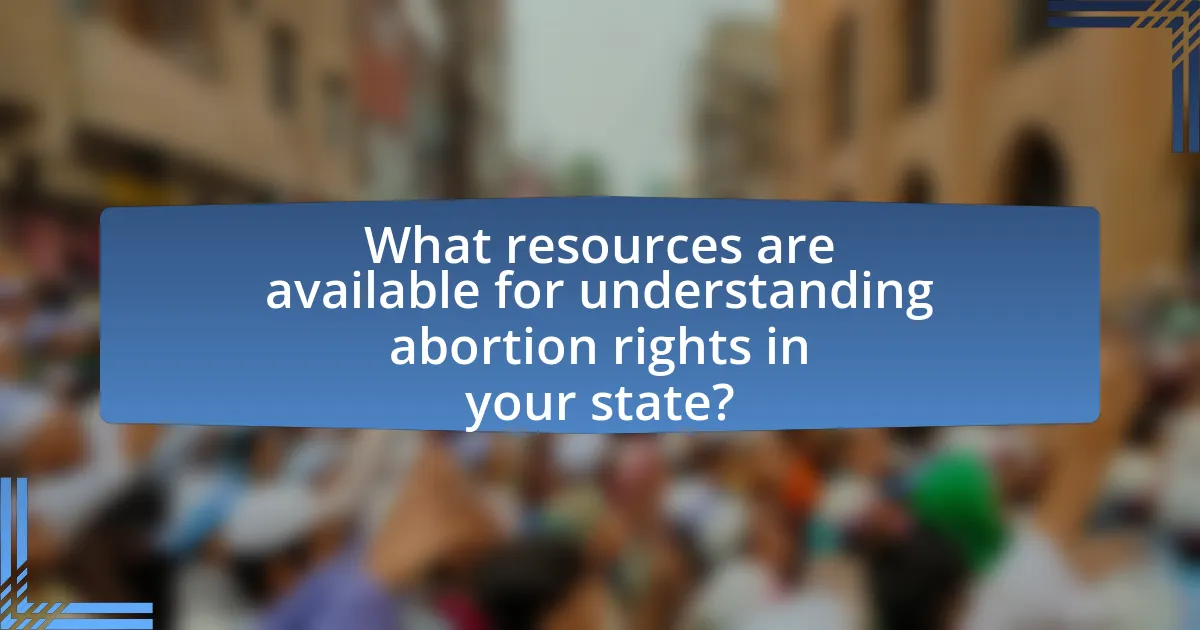
What resources are available for understanding abortion rights in your state?
To understand abortion rights in your state, you can access resources such as state government websites, legal aid organizations, and reproductive health advocacy groups. State government websites typically provide official information on current laws and regulations regarding abortion, including any recent changes. Legal aid organizations, like the American Civil Liberties Union (ACLU) or Planned Parenthood, offer guidance on legal rights and access to services. Additionally, local reproductive health advocacy groups often provide educational materials and support networks to help individuals navigate their rights and options. These resources are essential for obtaining accurate and up-to-date information on abortion rights specific to your state.
How can individuals stay informed about changes in abortion laws?
Individuals can stay informed about changes in abortion laws by regularly checking reputable news sources, government websites, and legal advocacy organizations. These platforms provide timely updates on legislative changes, court rulings, and policy shifts related to abortion rights. For instance, organizations like the Guttmacher Institute and the Center for Reproductive Rights frequently publish reports and analyses on state-specific abortion laws, ensuring that individuals have access to accurate and comprehensive information. Additionally, subscribing to newsletters from these organizations can facilitate ongoing awareness of developments in abortion legislation.
What organizations provide updates and support regarding abortion rights?
Organizations that provide updates and support regarding abortion rights include the Planned Parenthood Federation of America, the American Civil Liberties Union (ACLU), and the Center for Reproductive Rights. Planned Parenthood offers comprehensive reproductive health services and advocacy, while the ACLU focuses on protecting individual rights and liberties, including reproductive rights, through litigation and public education. The Center for Reproductive Rights works globally to advance reproductive rights through legal advocacy and policy reform. These organizations actively monitor changes in abortion laws and provide resources to support individuals seeking information and assistance related to abortion rights.
How can individuals advocate for reproductive rights in their states?
Individuals can advocate for reproductive rights in their states by engaging in grassroots organizing, contacting legislators, and participating in public demonstrations. Grassroots organizing involves mobilizing community members to raise awareness and support for reproductive rights initiatives, which can lead to increased public pressure on policymakers. Contacting legislators through emails, phone calls, or in-person meetings allows individuals to express their views on reproductive rights and encourage lawmakers to support relevant legislation. Participating in public demonstrations, such as rallies or marches, can amplify voices advocating for reproductive rights and draw media attention to the cause. According to a 2021 report by the Guttmacher Institute, states with active advocacy groups and public engagement often see more favorable outcomes in reproductive rights legislation.
What practical steps can individuals take regarding abortion rights?
Individuals can advocate for abortion rights by engaging in grassroots activism, supporting relevant organizations, and educating themselves and others about reproductive rights. Grassroots activism includes participating in local protests, contacting elected officials to express support for abortion rights, and mobilizing community members to raise awareness. Supporting organizations such as Planned Parenthood or the Center for Reproductive Rights provides financial resources and volunteer efforts that strengthen advocacy initiatives. Additionally, educating oneself on the legal landscape, including state-specific laws and recent changes, empowers individuals to inform others and advocate effectively. For instance, the Guttmacher Institute provides comprehensive data on state laws and policies regarding abortion, which can be instrumental in understanding the current legal environment.
How can individuals access safe abortion services in restrictive states?
Individuals can access safe abortion services in restrictive states by seeking out telehealth options, traveling to states with fewer restrictions, or utilizing organizations that provide logistical support. Telehealth services allow individuals to consult with healthcare providers remotely, which can facilitate access to medication abortions. For those who can travel, states like California and New York have more accessible abortion services. Organizations such as the National Abortion Federation and Planned Parenthood offer resources and assistance for individuals navigating these options, including financial aid and transportation support.
What are the best practices for navigating state-specific abortion laws?
To navigate state-specific abortion laws effectively, individuals should first research the specific regulations and restrictions in their state, as these laws can vary significantly. For instance, some states have waiting periods, mandatory counseling, or parental consent requirements, while others may have more liberal access. Utilizing resources such as the Guttmacher Institute or Planned Parenthood can provide accurate and up-to-date information on state laws. Additionally, consulting with healthcare providers who are knowledgeable about local regulations can help clarify the legal landscape and ensure compliance with all necessary procedures. Engaging with local advocacy groups can also offer support and guidance tailored to the specific legal context of the state.

